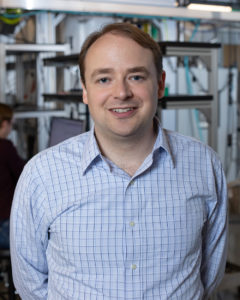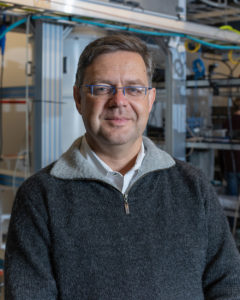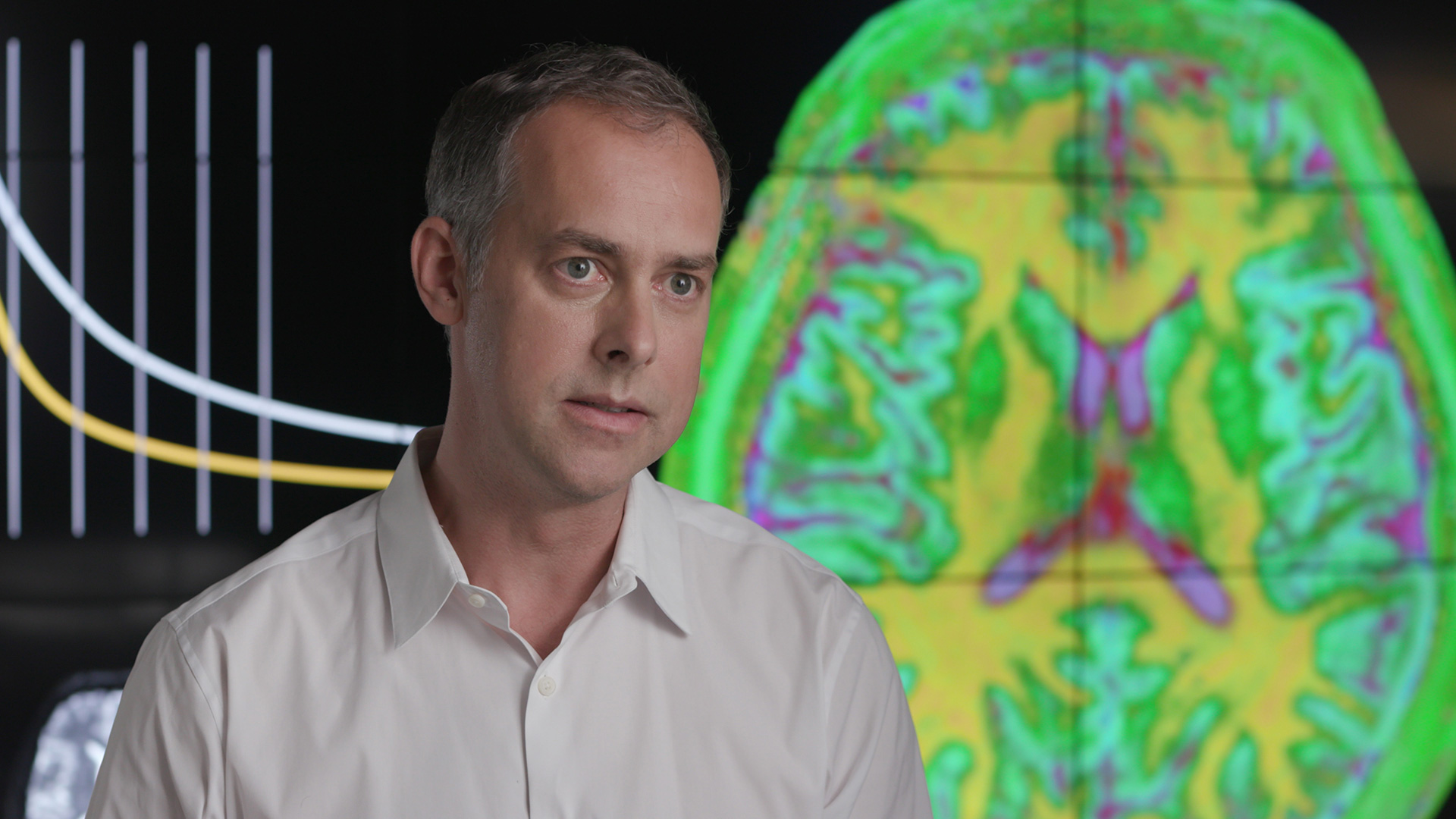Today, someone with breast cancer may undergo several rounds of chemotherapy and spend months in limbo before medical scans can show if that particular cocktail of toxic drugs is shrinking the tumor.
Case Western Reserve University researchers are working to change that. They have pioneered a new approach called Magnetic Resonance Fingerprinting, which uses more sensitive scanning techniques that they expect could detect whether treatments are working after just one dose of chemo.
“We think we can begin to see those changes within a week, as compared to six months,” said Mark Griswold, Case Western Reserve professor of radiology and director of MRI research. “That’s really important for both patient outcomes and quality of life, because if your chemotherapy isn’t working, you just poisoned your body for nothing.”
The new method has incredible promise, but designing the scans to quickly and accurately diagnose disease is a vastly challenging computational problem requiring innovative approaches. Now the Case Western Reserve researchers have found a solution to that problem — and seen dramatic improvements — using algorithms developed by Microsoft’s quantum computing team.
Microsoft’s “quantum-inspired” algorithms, designed to take advantage of future quantum computers, borrow from principles of quantum physics to solve extremely difficult computational problems. But they are also able to run on classical computers that are widely available today.
They’ve enabled the Case Western Reserve team to produce scans that are up to three times faster than prior state-of-the-art approaches, as well as scans that are almost 30 percent more precise in measuring a key identifier of disease.
Those advances could help doctors detect cancer and other diseases earlier, develop new drugs for conditions where progress is hard to measure today or use imaging to diagnose cancers rather than relying on invasive procedures like biopsies.
Microsoft’s quantum-inspired algorithms are particularly useful for optimization problems — which involve sifting through a vast number of possibilities to find an optimal or efficient solution — that are so complex and require so much computing power that current technologies struggle to solve them.
Typical examples might include ensuring traffic flows smoothly across an entire metropolitan area, allocating gate and tarmac space at a busy international airport or determining how to best sequence complicated manufacturing processes across many different pieces of equipment.
In addition to enhancing Case Western Reserve’s work to more quickly and reliably detect cancer and other diseases, Microsoft’s quantum team is also partnering with the Dubai Electricity and Water Authority, which is using quantum-inspired algorithms to figure out how to ideally balance resources from different energy sources across its entire electric grid.
Willis Towers Watson, a global advisory, brokerage and solutions company, is also exploring how Microsoft’s quantum-inspired algorithms might improve the complex mathematical models the company uses to quantify risk and inform investment strategies.
Microsoft researchers developed the algorithms as part of a larger effort to create the industry’s most stable and scalable quantum computer using quantum information particles called topological qubits. Once it’s built, the researchers say the quantum computing platform could allow scientists to do computations in minutes that would take current computers billions of years.
The quantum-inspired algorithms simulate how those systems work but can be run on existing computers. As development of a general-purpose quantum computer continues to progress, companies today can join the Microsoft Quantum Network to access new quantum-inspired services that work with Microsoft Azure and classical computer hardware like central processing units (CPUs), graphics processing units (GPUs) and field programmable gate arrays (FPGAs).
“It turns out that quantum thinking and lessons we’ve learned from programming the computer have led us to a breakthrough that we can run today classically,” said Julie Love, Microsoft’s director of quantum business development.
That’s allowing the Microsoft team to develop and accelerate customer solutions in healthcare, financial management, oil and gas and automotive industries, she said.
“More powerful hardware is coming, but these quantum advances are happening now,” Love said.

Julie Love, Microsoft director of quantum business development. Photo by Mark Malijan.
‘Results we just haven’t been able to see with anything else’
As any parent knows, it’s possible to put your hand on a child’s forehead and get a useful sense of whether he or she might be running a fever.
But without a thermometer to measure the temperature, it’s harder to make an informed decision about what to do — whether to wait and see, treat with medicine or rush to the hospital.
Magnetic resonance fingerprinting is a technique to give doctors interpreting an MRI that same degree of quantitative precision across a range of tissue properties, rather than relying on experience to subjectively decide whether the brightness or color of a particular area indicates the tissue is diseased or healthy. It’s currently in use at a dozen academic medical centers, and more widespread adoption is expected in coming years, researchers said.
“Millions and millions of people have been saved or had their lives improved by MRI, but largely what we’ve done so far is the equivalent of putting our hand on someone’s head,” said Griswold. “The big change that fingerprinting allows is that we can get the numbers, like a temperature reading, that allow you to directly make a diagnosis.”
Magnetic resonance fingerprinting, which has been shown to outperform comparable quantitative MRI protocols by a factor of 1.8, produces numerical measurements of tissue properties for each and every pixel of an image. It accomplishes this by using far more intricate pulse sequences — harmless radio waves that combine with magnetic fields to generate distinctive signals from different types of fat, tissue or tumors within a patient’s body.
Those data-intensive patterns are then compared to a vast library of tissues with a known magnetic resonance “fingerprint” that can be calculated directly from physics simulations. With sufficient precision, a pattern match alone could be used to diagnose colon or brain cancer, sparing patients from painful or invasive diagnostic procedures.

Stephen Jordan, Microsoft senior researcher. Photo by Mark Malijan.
And in conditions like multiple sclerosis and epilepsy, the fingerprint scans can pick up changes in the brain that are invisible with conventional methods yet are more clinically meaningful than the ones doctors can see today. That could help better predict how the disease will progress in a patient or determine whether new drugs are effective at combating diseases for which there’s currently no good measure of success.
The trick with magnetic resonance fingerprinting is figuring out which out of the exponentially vast universe of possible pulse sequences will produce scans quickly and with enough accuracy to distinguish between healthy tissue and different manifestations of disease. Because each sequence is made up of many individual pulses that can each vary by angle, intensity or duration, the number of potential sequences for complex acquisitions is immense — rivaling the number of atoms in the visible universe.
“Very quickly this becomes a problem with so many possibilities that are all coupled to each other that traditional optimization methods really struggle to solve it in any realistic way,” Griswold said. “There are unique advantages with the quantum-inspired algorithms that are allowing us to get results that we just haven’t been able to see with anything else.”
The pulse sequences picked by Microsoft’s optimization algorithms have provided scans up to three times faster than previous ones — which would increase throughput, drive down costs and improve access to a potentially lifesaving diagnosis, particularly in areas that have months-long waits for MRIs.
And the approximately 30 percent boost in precision for T2 measurements, which can be an important identifier of disease, could mean the difference between catching a tumor early and not seeing it until promising treatment options are limited.
“We have been able to show really significant gains that go way beyond just tweaking the system a little bit,” said Griswold, who also serves as the faculty director for Case Western Reserve’s Interactive Commons. “I feel like the quantum-inspired algorithms and the quantum computer are literally going to give us the next quantum leap. You’re never going to get those massive changes in your business by doing things the same old way.”
Discovering quantum-inspired algorithms
In a quantum computer, the unique properties of qubits — in particular, their ability to hold a value of 0 and 1 at the same time — allow them to process information exponentially faster and potentially find solutions to problems around climate change and world hunger that are simply not possible today. But because the quantum particles are notoriously finicky and unstable, Microsoft is working to develop more reliable and scalable qubits that can support a full quantum computing platform.
A different type of machine called a quantum annealer uses other mind-bending properties of quantum particles to perform a single task: solving optimization problems with lots of complicated variables and constraints.
“As I talk to enterprise customers, these hard optimization problems come up again and again and again,” said Microsoft’s Love. “I may have a room full of people in financial services, pharma, oil and gas, automotive, industrials or chemical companies and you will hear everyone saying, ‘Oh my god, yes, yes, I have these.’”
Originally researchers were just investigating how quantum annealers worked, so they developed algorithms to simulate what was going on inside. By chance, they decided to test their classical but quantum-inspired algorithms on a popular optimization test and discovered that they blew other solutions away.
“It was one of those things where you think you’re doing a science project on one topic and you discover something off to the side and realize that’s much more exciting,” said Stephen Jordan, a Microsoft senior researcher who is now working to apply quantum-inspired algorithms to real-world business and research problems.

Matthias Troyer, Microsoft principal researcher. Photo by Mark Malijan
“It made a big stir among optimization people who were like, ‘Who are these guys out of nowhere? They’re not even computer scientists! They are quantum physicists who have these wacky algorithms that are way better,’” he said.
To solve optimization problems, computers look for a solution that requires the lowest amount of effort or cost. In some cases, though, that’s like a mountain climber who’s trying to find the absolute lowest point in an unfamiliar, highly irregular, mountainous landscape.
Once he or she reaches a particular valley, there’s no way of knowing whether there’s a lower point over the next mountain. And finding out requires a huge amount of energy to climb up and over the next steep hill. So they may decide it’s not worth it and get stuck there — never finding the lowest point or better solution.
Quantum particles have a unique property that, in this example, allows them to easily tunnel through the mountain to discover what’s on the other side. By mimicking this tunneling ability, Microsoft’s quantum-inspired algorithms are able to solve optimization problems in entirely new ways — using hardware that’s widely available.
And when a fully-fledged quantum computer built on stable topological qubits becomes available, the same algorithms will become even more powerful, said Matthias Troyer, Microsoft’s principal researcher on the quantum computing team.
“Any of the quantum-inspired algorithms can be further accelerated on quantum hardware. By running them on classical hardware, we don’t get all the advantages yet,” Troyer said. “This isn’t just a classical one-off. It’s fully on the way to quantum computing.”
Related to quantum-inspired algorithms:
- Visit: Microsoft Quantum Computing
- Watch: 360° video tour of Microsoft’s quantum computing lab
- Learn More: Microsoft Quantum Network
- Read: Microsoft Quantum Blog
- Read: With new Microsoft breakthroughs, general purpose quantum computer moves closer to reality
Jennifer Langston writes about Microsoft research and innovation. Follow her on Twitter.
Top image: Mark Griswold, Case Western Reserve University professor of radiology, is using Microsoft’s quantum-inspired algorithms to boost the speed and accuracy of MRI scans using an innovative approach called magnetic resonance fingerprinting. Photo by Microsoft.


